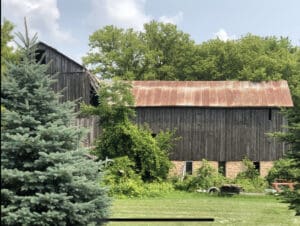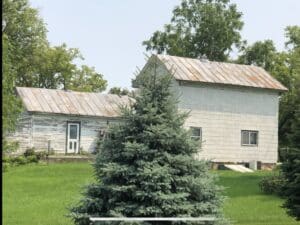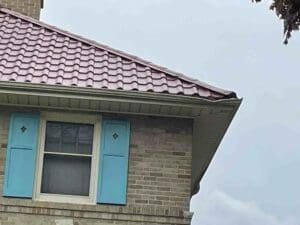Not a day goes by that I don’t see an ad for a metal roof and a common question I get is, “are metal roofs a good idea”? The straight answer is, “it depends”. But before rushing out to buy a metal roof you should go into it with the knowledge of whether it makes sense for your house in your climate.
But like everything there are pros and cons. After reviewing this article, you will should have all the information you need to decide if metal is right for you.
Pros
Durability – This one is a double edged sword. While they can last a long time, they do require maintenance. It’s a good option for a cottage or vacation home where you are not there all the time, more especially if you live in a very windy area where the house is at risk of shingle blow off once the shingles get to be 30 years old and the sealants start to wear out. If you can’t rely on a neighbor who lives near the home year round to tell you when there’s damage, this is a good option.
Recyclable – Once your metal roof fails, it can be taken to a scrap yard and recycled.
Cons
Price – Metal roofs are typically 2 to 3x the price of even a well done asphalt roof.
Cell phone signals: If you have a metal roof, you will likely find your signal is not as good as it was before your roof. However, as long as you don’t have steel siding, you may still be able to get a signal. You are essentially putting yourself in a Faraday cage.
Painting Required – Yes, we’ve all see the advertising. But like all painted surfaces, especially those that are exposed to the sun, it will wear off. A prudent homeowner will have them repainted or coated before the galvanization wears off. However, there are some very good acrylic or silicone coatings that work well.
Rust – Ignore this and you’ll have problems sooner than you had hoped. Once you see rust starting, you need to get the roof coated ASAP.
Avalanching – This is only a problem for those who live in snowy climates. If you have a door with an eve over it, let’s hope you have a nice big soffit overhang. When the temperature starts to come up on a snow covered roof, snow starts to melt and that layer of ice and snow can slide off and hurt someone if you happen to be the poor soul walking out the door at just the wrong time. When you close the door behind you, don’t slam it. Any micro vibration can cause the ice and snow to let loose on a roof. This can be mitigated by putting up snow bars or ice diamonds that help prevent the snow and ice from sliding off your roof to disastrous consequences. Now ask yourself how well your gutters will fare when 1000 pounds of ice and snow start to slide off of your roof?
Fasteners leaking – Some roofs are secured by screws with rubber washers. Sometimes referred to as “barn steel”, these rubber washers can dry out and break down. Once that happens, you’ll need to have them caulked. If you spend a little bit more, the standing seam roofs don’t have the same amount of fasteners. Neoprene or rubber washers will expand and contract with temperatures and they also dry out. In short, washers wear out. If you really want a metal roof, spend the extra money on a standing seam roof without exposed fasteners.

Oxidation – All metal oxidises. Once that happens your roof will no longer have that new or shiny look. Perforations prone to leaking.
Flashings – Many of the flashings, such as those around soil pipes to vent out sewer gases, are butyl rubber. These can wear out from UV rays. A dark colored roof will hasten the breakdown of rubber accessories. They can last as little as 8 to 10 years before needing maintenance. This isn’t an issue on barns since they have typically have simple roofs with no perforations.
Denting – If you have trees over your home, there’s a good chance it will dent. If an installer needs to go up on your roof, he needs to be very careful to step in the right areas. If you do still desire a metal roof, go with the thickest gauge you can afford in order to reduce this kind of problem and hire a professional who is familiar with the kind of roof you purchased. Understand that thinner gauges will be more susceptible to denting from hail. If your sales rep doesn’t explain gauges, don’t hire them.
Fire – Hopefully you never have a fire, but if you do, your local Fire Department typically uses a chainsaw to get through a roof. Good luck getting through a metal roof with a chain saw. Everything inside will burn like an oven.
Costly Underlayments – Normal ice and water membrane should not be used under a metal roof. Manufacturers recommend high temperature ice and water membrane since they know the metal roof will heat up.
Note: Some, but not all, of these cons can be mitigated or reduced by the roofs that look like shingles and are coated with an epoxy and granule mix.
Steel that looks like shingles
Products like DecraSteel are a beautiful alternative. These products are installed like siding, starting from the bottom of the roof and moving up. They come with their own challenges…
Repairs are nearly impossible. They lock into place and build up. But what happens when a branch falls on the edge of your roof? They’re like steel siding — when a piece gets damaged on the bottom, to properly repair it you have to remove the siding from the top down. Good luck getting an installation company to come back. Avoid this problem by cutting down and eliminating any trees that could fall on your roof prior to installation.
Gutters must be replaced as part of this project. There is a flashing called gutter apron. It is like a hyper extended L shaped piece of metal that is nailed to your roof decking and hangs down into the gutter. If you are doing a new roof, you should replace this with an aluminum gutter apron which will not rust. In the best case, your roof installer will understand the importance of putting on a gutter apron that drops 3 inches on the vertical along the fascia. This will allow your gutter installer to properly pitch your gutter so the water drains toward a downspout. Do not try to reuse your gutters. This is the wrong time to go cheap. If you’re spending the money, do it right the first time.
Gutter protection challenges: Once that roof is on, you won’t be able to slide the top of a piece of gutter protection under a shingle. Plan accordingly. Not all gutter protection products will be compatible.



